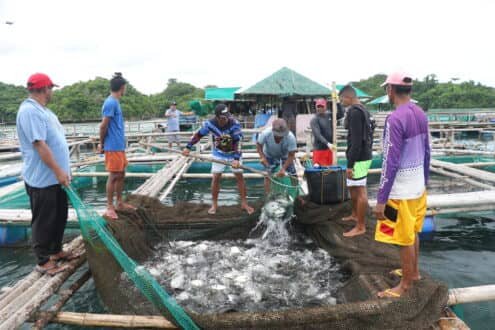The Philippines – Humans are not the only ones who enjoy eating spaghetti—shrimp can, too. Researchers are using nutritious green “spaghetti algae” in fish and shrimp feeds as part of a broader move to bring down the cost of expensive aquafeeds which account for over half the expenses of farmers.
“The ultimate aim of using spaghetti algae, or any other alternative ingredient, in aquafeed is to bring down the feed cost in aquaculture,” said Joseph Biñas, associate researcher and feed mill supervisor at the Southeast Asian Fisheries Development Center Aquaculture Department (SEAFDEC/AQD) in Tigbauan, Iloilo.
Biñas further said that, “The use of alternative ingredients, especially if these are locally available and sustainably produced, may considerably reduce the cost of formulated feeds.”
Chaetomorpha linum, also known as “spaghetti algae” or “green hair algae”, derives its name from its wiry and rigid strands, forming a loosely entangled mass resembling cooked pasta noodles.
According to Biñas, spaghetti algae is being considered as a source of nutrition because it has a protein content of up to 17 percent and contains various health-promoting bioactive compounds.
He also added that this species of algae grows locally year-round and can tolerate a wide range of environmental conditions. While growing, spaghetti algae also absorbs excess nutrients from aquaculture wastewater, thereby helping to reduce pollution.
Testing spaghetti algae on shrimp
In his SEAFDEC/AQD-funded research which is scheduled to be completed this year, Biñas and his colleagues included various amounts of the algae into aquafeeds, partially substituting soybean and fishmeal which are more expensive imported ingredients.
Stay Always Informed
Join our communities to instantly receive the most important news, reports, and analysis from the aquaculture industry.
The feeds, containing between zero and 18 percent processed spaghetti algae, were then tested for 90 days on juveniles of tiger shrimp, also locally known as lukon or sugpo.
The results were promising as shrimp survival and growth were normal with up to 12 percent spaghetti algae in their diet. Biñas, however, said the sweet spot seemed to be at around 6 percent.
He also said that they continue to improve the quality of the spaghetti algae by using lactic acid bacteria, yeast, and fungi to ferment it before including it in feeds. Fermentation improves the nutritional quality of alternative protein sources.
“Once the fermentation protocol is optimized, fermented spaghetti algae can then be produced in large scale quantities,” he remarked.
Biñas also said that spaghetti algae would later be tested as a potential feed source for tilapia and milkfish.
Source: SEAFDEC Aquaculture Department
Editor at the digital magazine AquaHoy. He holds a degree in Aquaculture Biology from the National University of Santa (UNS) and a Master’s degree in Science and Innovation Management from the Polytechnic University of Valencia, with postgraduate diplomas in Business Innovation and Innovation Management. He possesses extensive experience in the aquaculture and fisheries sector, having led the Fisheries Innovation Unit of the National Program for Innovation in Fisheries and Aquaculture (PNIPA). He has served as a senior consultant in technology watch, an innovation project formulator and advisor, and a lecturer at UNS. He is a member of the Peruvian College of Biologists and was recognized by the World Aquaculture Society (WAS) in 2016 for his contribution to aquaculture.




